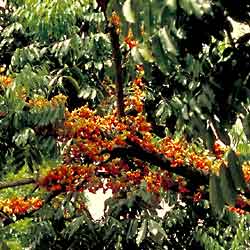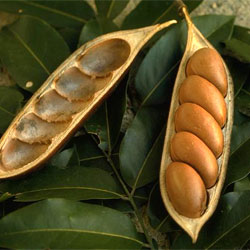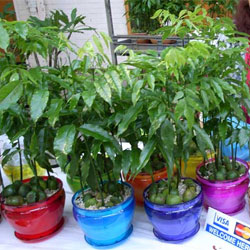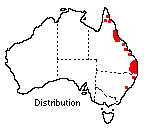Castanospermum australe
 |
 |
 |
 |
Black Bean, Moreton Bay Chestnut
Castanospermum australe A.Cunn. ex Mudie
 The
genus Castanospermum belongs to the Fabaceae family and has only one
species - Castanospermum australe, commonly referred to as the Black
Bean or the Moreton Bay Chestnut.
The
genus Castanospermum belongs to the Fabaceae family and has only one
species - Castanospermum australe, commonly referred to as the Black
Bean or the Moreton Bay Chestnut.
It is native to coastal rainforests and beaches in Australia from around Lismore, New South Wales to the Iron Range, Cape York Peninsula on the Queensland coast and 160 km west to the Bunya Mountains. It grows in moist, fertile, well-drained soils on terraces on the side of mountains or along the banks of rivers and streams. The Black Bean is also found in New Caledonia and Vanuatu. It reaches a height of 40 metres at maturity.
Castanospermum australe is a hardy species that is suited for a wide range of conditions throughout Australia, including Melbourne where it may grow to 8 metres. Full sun is recommended, however shady situations are tolerated, as is light frost. Under cultivation it will develop a dense rounded canopy and reach a height of 8-20 metres with a spread of 4-8 metres. Thus it is an ideal shade tree in parks, resorts and gardens, in addition it has a strong root system, which can be used to consolidate stream banks against erosion.
This is a handsome tree with glossy dark green pinnate leaves and low spreading branches when grown in the open. During October - November, it bears sprays of red and yellow pea-shaped flowers 3-4 cm long, which are partly hidden by the dense foliage. Following flowering in March - May, large cylindrical pods measuring 12-20cm by 4-6 cm are produced. These pods split in two, revealing 3-5 large bean like seeds weighing about 30 grams. The nectar produced by the flowers attracts birds, bats and butterflies.
Propagation of this species is from fresh seed. Germination requires a temperature of 18C - 25C. Sow in large, individual tubes using a mix of 3 parts river sand and 1 part perlite. Transplanting should be done after the first pair of true leaves have formed. Plant the seedling in a bed of thoroughly loosened, moist soil (pH of approx. 5.9 is preferred), mulch around the base of the plant and water regularly. The Black Bean is slow to establish but will respond to liquid fertilizer (NPK), which should be firstly applied 3 months after germination. May occasionally be affected by scale insects and psyllids. Over-watering may cause fungal root rot.
Black Bean also makes an ideal indoor plant, and is widely available in florists and nurseries. Plant the seedlings in a commercial potting mix with slow release fertilizer added. Multiple plantings of 10-15 plants (see photo) will give a good display. It will tolerate low, filtered light to full sun if gradually introduced.
There are a few factors that should be taken into account before growing this species:
* The leaves and seeds are toxic to livestock.
* Due to its extensive root system, it should not be planted within 10 metres
of drainage lines, sewers, house foundations, garages or swimming pools.
The Black Bean has also proved valuable as a timber species, it's seeds have been utilized - following extensive preparation as a food by Aborigines and it contains alkaloids which have been shown to have anti-HIV and anti -cancer properties.
Text by Mojca Debevec (2002 Student Botanical Intern)
Name meaning: Castanospermum - from two words, castanea Latin for chestnut
and spermum Greek for seeded. |
References
Bailey, R. & Lake, J. (2001). Gardening with Australian Rainforest Plants. Bloomings Books, Melbourne.
Elliot, W.R. & Jones, D.L. (1982). Encyclopaedia of Australian Plants Suitable for Cultivation. Pp 477 - 478. Lothian Publishing Company, Melbourne.
Wrigley, J.W. & Fagg, M. (1992). Growing Native Plants Indoors. Simon & Schuster, Roseville, NSW.
![An Australian Government Initiative [logo]](/images/austgovt_brown_90px.gif)

